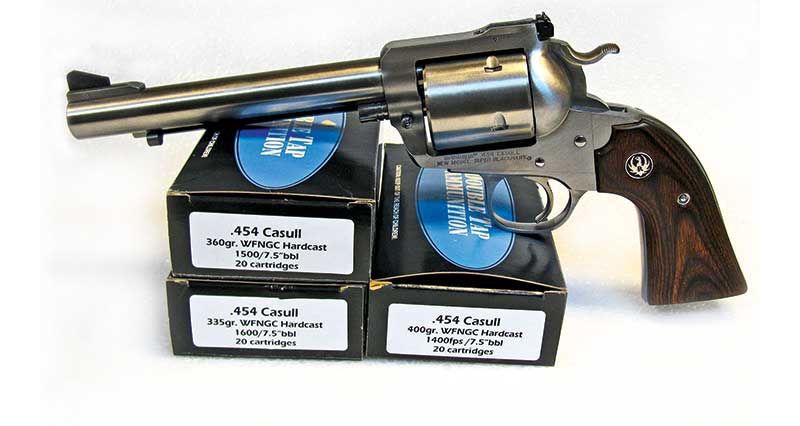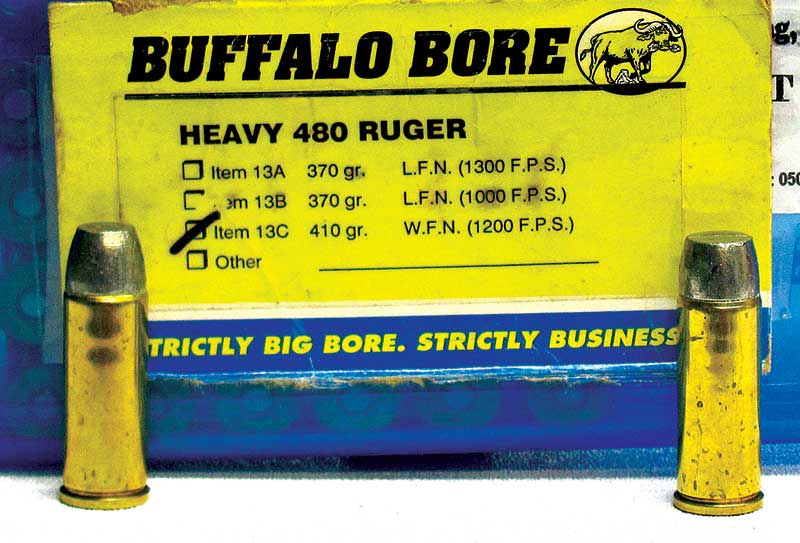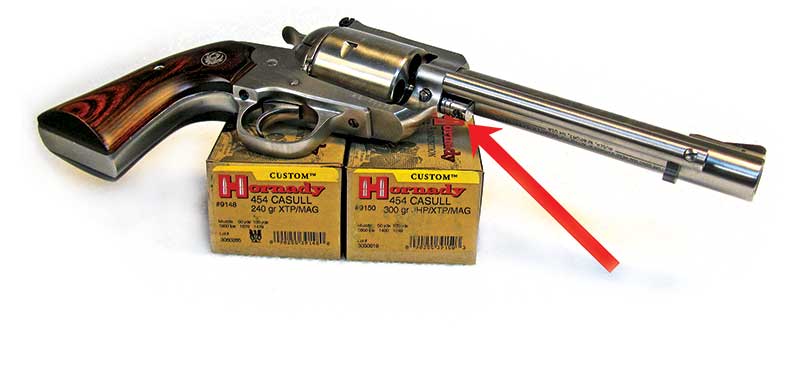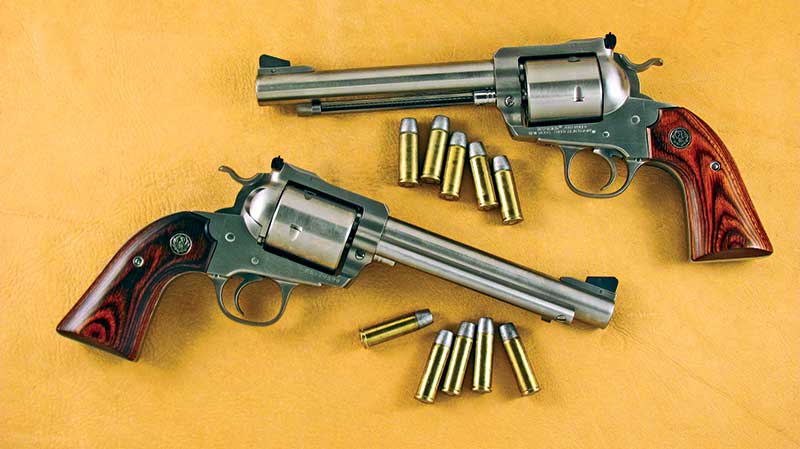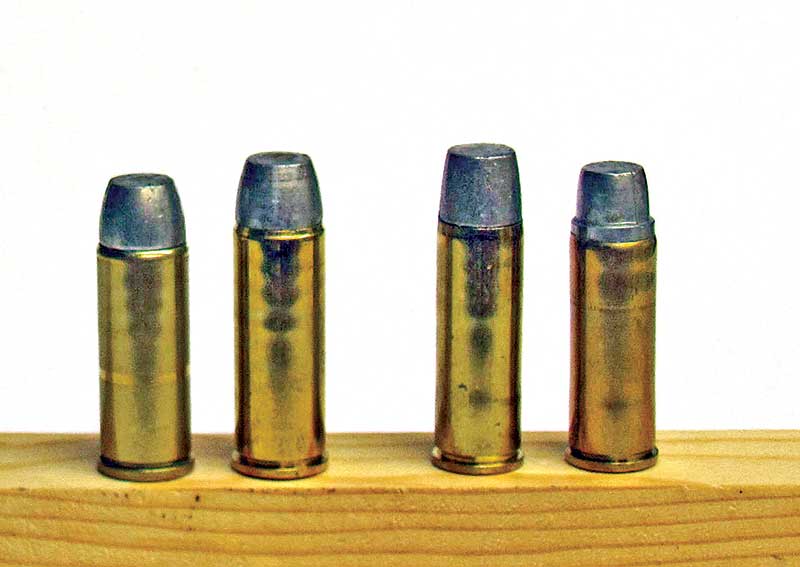Ruger’s Big-Bore Bisleys
Ruger brought out their first Bisley Models in the mid-1980’s chambered in .357 Magnum, .41 Magnum, .44 Magnum and .45 Colt. All of these had 6-shot cylinders. Custom gunsmith John Linebaugh converted one of the first .357 Magnum Ruger Bisley Models to his 5-shot .500 Linebaugh for me. I would not want to shoot this powerful sixgun without the Bisley grip frame.
The roots of the Ruger Bisley grip frame go back well over a century. In 1896 Colt sought to turn their Single Action Army into a target pistol. To do this they added relatively crude adjustable sights, a target trigger and hammer and drastically changed the grip frame. The backstrap was made to come up higher while the front strap also came up higher, with both of these being done so the grip frame would sit deeper in the hand and not twist in recoil.
In the 1980’s Ruger took a good look at the concept and came up with a much better solution, with the Ruger Bisley Model grip frame. The backstrap still comes up high in the back however it fills in more behind the trigger guard giving a very solid feeling grip and one doing what many consider the best job of handling recoil — heavy recoil that is — in any single action.
Fast Learners
With Ruger producing the Bisley Model in the above four chamberings and custom sixgunsmiths using the basic Ruger Bisley for 5-shot conversions of both Linebaugh’s cartridges as well as others, it wasn’t long before shooters began petitioning Ruger for a factory produced five-shot Bisley Model. For years the pleas only fell on deaf ears. However, thanks to Ruger distributor Lipsey’s we have a Bisley Model 5-shooter. The natural chambering of course was the .454 Casull, however Ruger also had its own big bore cartridge which debuted in the early years of the new century in the Ruger Super Redhawk.
This cartridge was a joint collaboration between Hornady and Ruger. To come up with the first cartridge to bear the Ruger name, Hornady apparently took a good solid look at the .475 Linebaugh and felt there was a need for something which was not quite so powerful, and the result was the .480 Ruger which is simply the .475 Linebaugh trimmed to 1.285″ from 1.400″. The .480 Ruger can be fired in any sixgun chambered for the .475 Linebaugh but not vice versa, and any .45 Colt can be fired in the .454 Bisley Model.
Now the Ruger Bisley Model, the .454 and the .480 Ruger have all come together in a new stainless steel, 61/2″ barreled Big Bore Bisley and it’s only available from Ruger through Lipsey’s. I’ve never been a fan of the 61/2″ barrel length in a single action, however this new Ruger has the longer 5″ ejector rod housing and the result is a nicely balanced and very good-looking 5-shot revolver. By using a 5-shot cylinder, as Dick Casull found out 60 years ago, more steel is in-between chambers and most importantly the cylinder bolt cuts are not under the chamber but rather in between, resulting in more strength.
Problems
One of the problems inherent in heavy recoiling cartridges in single action sixguns is the possibility of having an unsupported loading gate. There are two ways to support the loading gate. One is by always having a cartridge case under the loading gate to support it when the sixgun is fired or by having recessed case heads allowing the cylinder to be long enough to provide the necessary support to the loading gate. Without one of these two options more than one shooter has seen his loading gate break. Ruger chose to go with recessed cylinders.
Another problem also inherent in single actions is keeping the base pin where it belongs. Originally the black powder Colts used a screw which entered diagonally from the front of the frame and held the base pin in place. About the time black powder was replaced by smokeless powder Colt changed to a spring-loaded base pin catch which did not and does not always work, especially with heavier recoiling cartridges. I have had more than one base pin come out, not just with .44 Magnum cartridges fired in the Ruger Blackhawk but also have launched base pins out of Colt Single Actions chambered in .45 Colt or .44 Special. More than a few of these base pins are still scattered around sagebrush in southwestern Idaho.
Years ago Belt Mountain Base Pins began offering locking base pins to replace the factory versions in both single actions. Ruger has wisely followed their lead and the Bisley Model base pins have a screw which enters from the bottom of the base pin head and fills in a notch in the bottom of the barrel. It never loosened at all during the time I was test-firing both the .454 and .480 Ruger versions.
When I started shooting single actions way too many years ago I learned to always carry a small screwdriver in my shirt pocket to keep all the screws tightened. One especially has to be careful of the screw holding the ejector rod housing to the barrel as if it loosens up enough recoil will bend the screw or even catapult the ejector rod housing.
Engineering Points
Both of these Bisley Models are heavy sixguns, with the .480 weighing in at an even three pounds, while the .454 weighs one ounce more according to my postal scale. Sights are the typical Ruger adjustable, with a fully adjustable rear sight matched up with a ramp front sight both of which are the way they should be — black. Trigger pulls on both guns are relatively smooth and weigh in at 31/2 lbs. according to my Brownell’s Trigger Gauge. Using pin gauges I took the measurement of the chamber mouths of both sixguns with the .454 accepting a 0.454″ gauge while the .480 Ruger measured out at 0.476″.
These sixguns are almost perfect — almost. Both of them exhibit what seems to be a standard problem with adjustable-sighted Rugers, namely the pin holding the rear sight in place has a tendency to back out. This is an easy fix by simply pinching one end of the pin and driving it back into place.
Shooting Thoughts
There was a time when I looked with anticipation at being able to shoot hundreds of rounds through such heavy recoiling sixguns. That time has long passed and I can no longer fire more than a few rounds at a time with such heavy recoil at the backend. So for serious testing of both of these guns I clamped the Ransom Rest to a solid concrete bench. I had started by using my 200 pound-plus shooting bench, however the recoil of even .45 Colt heavy loads moved the bench ever so slightly sideways resulting in horizontal strings on the target. The solid concrete bench solved this problem.
I started my testing by using some standard .45 Colt loads, however the results were quite disappointing. The .454 Ruger Bisley Model has a barrel with a 1:24″ twist which is just about perfect for heavy bullets at higher velocities but apparently doesn’t like standard bullets at standard velocities. One .45 Colt load which works exceptionally well is the Garrett Cartridges of Texas 45LFR (Long Frame Revolver) 365-gr. Hammerhead at just over 1,100 fps, grouping four shots in 1″ at 25 yards.
The most accurate loads through the .454 proved to be one which is no longer produced, that is the Black Hills 300 grain XTP load. Four shots group in 3/4″ at a muzzle velocity of 1,320 fps. Hornady’s 240 XTP-JHP at 1,700 fps and their 300 XTP-JHP at 1,500 fps both group exceptionally well with four shots in 7/8″. Last fall I used the Garrett Cartridges of Texas 365 Hammerhead .454 rated at 1,350 fps to take a 7×7 bull elk with one shot. From the Ruger Bisley Model this load clocks out at 1,200 fps and put four shots in 11/8″ at 25 yards. The heaviest bullet I tried was Double Tap’s 400 WFN at 1,125 fps and a 11/4″ group.
Turning to the .480 Ruger I had excellent results with Buffalo Bore’s Hard Cast loads, with the 370 LFN clocking out at 1,200 fps and a 3/4″ group, while their 410 WFN load, which I used to take my trophy bull bison several years ago with a one-shot kill at 35 yards, clocked out just over 1,115 fps with a four-shot group of 1″.
Most of my handloads for the .480 Ruger are put together with hard cast bullets and IMR4227. With 19 grains, a 435 LFN has a muzzle velocity of 1,050 fps and groups four shots in 1″ at 25 yards and using 22.5 grains for lighter bullets gives the 355 Oregon Trail FPGC a muzzle velocity of just under 1,100 fps and a group of 11/4″ while the 380 grain LBT LFN clocks out at over 1,125 fps and a 1” group with four shots at 25 yards.
My first hunting sixguns were Rugers; a .22 Single-Six for varmints, a .357 Blackhawk for small game and a .44 Magnum Blackhawk for larger game. I eventually added a 10″ Flat-Top .44 Magnum Blackhawk and carried it for years in a Goerg shoulder holster. Ruger has been supplying the needs of sixgun hunters for 60+ years now. This pair of Lipsey’s/Ruger Bisley Models may well be considered the finest hunting handguns they have ever offered.

